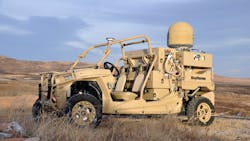Air Force asks Raytheon to provide additional laser-weapons all-terrain vehicle for defending against UAVs
WRIGHT-PATTERSON AFB, Ohio – U.S. Air Force laser weapons experts are ordering an additional counter-drone High Energy Laser Weapon Systems (HELWS) under terms of a $13.1 million order announced Thursday.
Officials of the Air Force Research Laboratory at Wright-Patterson Air Force Base, Ohio, are asking the Raytheon Space and Airborne Systems segment in McKinney, Texas, to build one additional HELWS for six months of in-field evaluation against enemy unmanned aerial vehicles (UAVs).
The Raytheon prototype HELWS combines a solid-state laser weapon with a Raytheon multi-spectral targeting system. The unit mounts to a military RZR all-terrain vehicle from Polaris Inc. in Medina, Minn.
This results in an advanced, lightweight, and adaptable weapons system that enables military mobile light forces to defend against enemy UAVs in a wide variety of conditions and terrain.
Related: Laser weapons show their stuff in real-world conditions
The Polaris Military RZR -- called M-razor -- is a gasoline-powered small all-terrain vehicle that seats four to six people, and can carry an additional 1,500 pounds of payload.
Air Force experts will use the new Raytheon HELWS for operator training for in-theater system maintenance; collecting availability, reliability, maintainability, and supportability data; and system operation against real-world or simulated hostile UAVs without disrupting other military operations.
On this order Raytheon will do the work in overseas locations, and should be finished by November 2020. for more information contact Raytheon Space and Airborne Systems online at www.raytheon.com, Polaris Inc. at https://military.polaris.com, or the Air Force Research Laboratory at www.wpafb.af.mil/afrl.
About the Author
John Keller
Editor-in-Chief
John Keller is the Editor-in-Chief, Military & Aerospace Electronics Magazine--provides extensive coverage and analysis of enabling electronics and optoelectronic technologies in military, space and commercial aviation applications. John has been a member of the Military & Aerospace Electronics staff since 1989 and chief editor since 1995.
